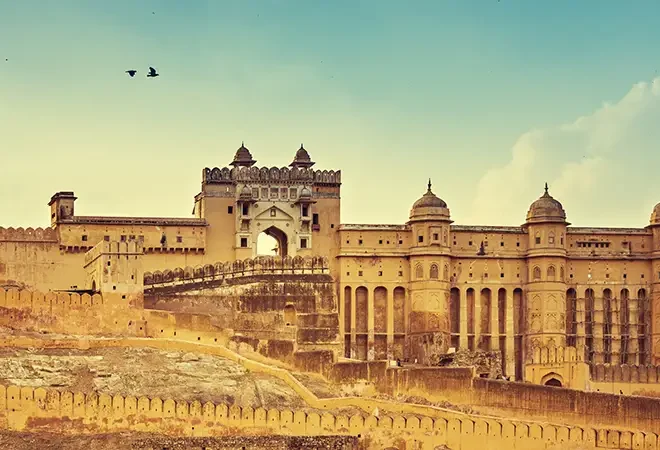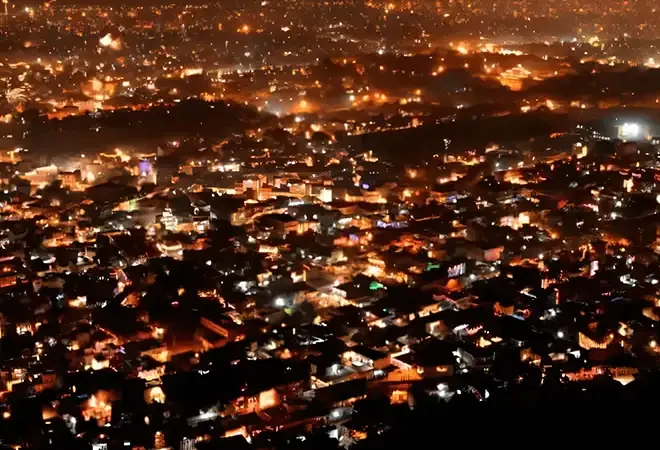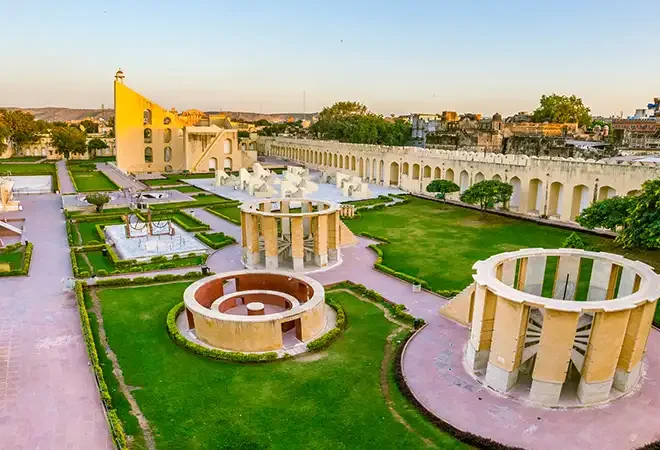
Unveiling the Best Places to Visit Near Jaipur in Rajasthan
Welcome to Rajasthan, a state renowned for its historical palaces, vibrant culture, and majestic landscapes. While Jaipur, the Pink City, may be on top of your must-visit list, there are also several enchanting attractions waiting to be explored in the vicinity. Get ready to uncover the best places to visit near Jaipur in Rajasthan that will leave you spellbound.
From the mesmerizing beauty of the lush green valleys in Ajmer to the awe-inspiring spirituality of Pushkar, each destination promises a unique experience. Delve into the richness of Rajput architecture at the grandiose Amer Fort or soak in the serenity of the stunning Jal Mahal, a palace floating on the shimmering waters of Man Sagar Lake. Embark on a safari adventure at the Ranthambore National Park and witness the regal Bengal tigers in their natural habitat.
| Section | Description |
|---|---|
| Why Visit Jaipur? | Highlights Jaipur’s allure and the surrounding attractions in Rajasthan. |
| Historical Landmarks in Jaipur | Details about Jaipur’s iconic historical sites like Amer Fort and Hawa Mahal. |
| The Majestic Amer Fort | Describes the grandeur and architectural brilliance of Amer Fort. |
| Exploring Hawa Mahal & City Palace | Insights into the significance and beauty of Hawa Mahal and City Palace. |
| Discovering Nahargarh Fort | Describes the fort’s historical importance and panoramic views of Jaipur. |
| Excursions to Ajmer & Pushkar | Highlights the spiritual and cultural attractions of Ajmer and Pushkar. |
| Exploring Udaipur | Showcases Udaipur’s City Palace, Lake Pichola, and the city’s royal charm. |
| Wildlife & Nature Near Jaipur | Highlights Ranthambore National Park, Sariska Tiger Reserve, and other natural attractions. |
Whether you’re an avid history buff, a nature enthusiast, or simply seeking a tranquil retreat, the places near Jaipur in Rajasthan will captivate your heart. Join us as we unveil the hidden gems and extraordinary attractions that make Rajasthan an irresistible travel destination. Let the journey begin!
Why visit Jaipur and explore nearby attractions?
Jaipur, the capital city of Rajasthan, is a dazzling jewel in the crown of India. Known as the “Pink City” for its vibrant hues, Jaipur is a mesmerizing blend of rich history, stunning architecture, and vibrant culture. However, the allure of Jaipur extends far beyond its city limits, as the surrounding areas of Rajasthan offer a wealth of enchanting attractions that are equally captivating.
By venturing beyond the boundaries of Jaipur, you’ll have the opportunity to uncover a treasure trove of historical sites, natural wonders, and cultural experiences that will leave a lasting impression on your heart and mind. From the majestic Amer Fort to the serene Pushkar, the destinations near Jaipur promise a diverse and unforgettable journey.
Whether you’re a history buff, a nature enthusiast, or simply seeking a rejuvenating escape, the places near Jaipur cater to a wide range of interests and preferences. Explore the grandeur of Rajput architecture, immerse yourself in the spiritual essence of sacred temples, or embark on thrilling wildlife safaris – the choices are endless. By expanding your horizons beyond the iconic Jaipur, you’ll gain a deeper understanding and appreciation of the rich tapestry that is Rajasthan.
Historical landmarks in Jaipur
Jaipur, the capital of Rajasthan, is a city steeped in history, boasting a rich cultural heritage that has captivated visitors for centuries. As the first planned city of India, Jaipur is home to a magnificent array of historical landmarks that offer a glimpse into the glorious past of the Rajput dynasty.
One of the most iconic and must-visit attractions in Jaipur is the majestic Amer Fort, a stunning example of Rajput architecture that sits atop a hill, overlooking the serene Maota Lake. This grand fortress, with its intricate carvings, mirrored halls, and sprawling gardens, transports visitors back in time, allowing them to imagine the grandeur of the Rajput rulers who once called this place home.
Another architectural marvel in Jaipur is the Hawa Mahal, or the “Palace of Winds,” a five-story pink sandstone structure with a unique honeycomb-like facade that was designed to allow the royal ladies to observe the bustling streets below without being seen. This iconic building, with its intricate latticed windows, has become a symbol of Jaipur’s rich cultural heritage and is a must-visit for any traveler exploring the city.
The majestic Amer Fort

The Amer Fort, perched atop a hill overlooking the serene Maota Lake, is a true gem of Rajasthan’s architectural legacy. This grand fortress, built in the 16th century by the Rajput rulers, is a stunning example of the region’s rich history and the ingenuity of its people.
As you ascend the winding road leading to the fort, the sheer scale and grandeur of the structure become increasingly apparent. The imposing walls, adorned with intricate carvings and intricate lattice work, stand as a testament to the skill and craftsmanship of the Rajput architects. The fort’s main entrance, known as the Suraj Pol (Sun Gate), is a magnificent gateway that sets the tone for the breathtaking sights that await within.
Once inside the fort, visitors are transported to a bygone era, where the opulence and splendor of the Rajput dynasty are on full display. The Diwan-e-Aam, or the Hall of Public Audience, is a grand hall where the rulers would hold court and address the public. The Diwan-e-Khas, or the Hall of Private Audience, is a stunning example of the fort’s architectural prowess, with its mirrored walls and ornate ceilings that create a mesmerizing visual effect.
As you wander through the fort’s intricate maze of courtyards, palaces, and gardens, you’ll be struck by the attention to detail and the seamless integration of form and function. The Sheesh Mahal, or the Palace of Mirrors, is a breathtaking example of this, with its intricate mirror work that creates a dazzling display of light and reflection. The Jai Mandir, with its delicate latticework and intricate carvings, is another highlight that showcases the Rajput’s mastery of design and craftsmanship.
Exploring the Pink City – Hawa Mahal and City Palace
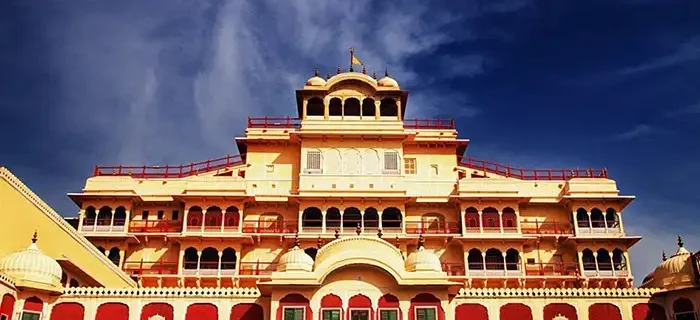
Jaipur, the vibrant capital of Rajasthan, is often referred to as the “Pink City” due to the distinctive hue of its historic buildings. At the heart of this enchanting city lies two of its most iconic landmarks: the Hawa Mahal and the City Palace.
The Hawa Mahal, or the “Palace of Winds,” is a stunning five-story structure with a unique honeycomb-like facade that has become a symbol of Jaipur’s architectural brilliance. This remarkable building, constructed in 1799, was designed to allow the royal ladies of the court to observe the bustling streets below without being seen. The intricate latticed windows and delicate pink sandstone create a mesmerizing visual that has captivated visitors from around the world.
As you step inside the Hawa Mahal, you’ll be transported to a bygone era, where the grandeur of the Rajput dynasty is palpable. The interior of the palace features a series of small windows and balconies that were designed to catch the cooling breezes, earning the structure its name. Visitors can climb to the top of the Hawa Mahal to enjoy breathtaking views of the city and the surrounding Aravalli hills.
Just a short distance from the Hawa Mahal lies the majestic City Palace, a sprawling complex that serves as a testament to the Rajput’s architectural prowess. This magnificent palace, built in the 18th century, is a harmonious blend of Rajput, Mughal, and European architectural styles, reflecting the diverse cultural influences that shaped Jaipur’s history.
As you explore the City Palace, you’ll be awed by the sheer scale and opulence of the structures, from the grand Chandra Mahal to the intricate Mubarak Mahal. The palace also houses several museums, showcasing the rich cultural heritage of the Rajput dynasty, including an impressive collection of traditional costumes, textiles, and miniature paintings.
Discovering the beauty of Nahargarh Fort

Perched atop the Aravalli Hills, the Nahargarh Fort stands as a majestic guardian over the city of Jaipur, offering visitors a breathtaking panoramic view of the Pink City. This historic fort, built in the 18th century, is a testament to the strategic and architectural prowess of the Rajput rulers who once called it home.
As you ascend the winding roads leading to the fort, the anticipation builds, and the stunning landscape unfolds before your eyes. The fort’s imposing walls, adorned with intricate carvings and lattice work, create a striking silhouette against the backdrop of the Aravalli hills. The main entrance, known as the Suraj Pol, is a grand gateway that sets the stage for the architectural wonders that lie within.
Once inside the fort, visitors are transported to a bygone era, where the grandeur of the Rajput dynasty is palpable. The Madhavendra Bhawan, a palatial structure within the fort, is a true highlight, with its intricate frescoes, delicate lattice work, and stunning views of the city below. The Rang Mahal, or the “Palace of Colors,” is another architectural gem, featuring vibrant murals and exquisite tile work that showcase the artistic talents of the Rajput craftsmen.
But the Nahargarh Fort is not just a testament to the past – it is also a hub of contemporary art and culture. The fort’s Madhavendra Palace has been transformed into a stunning art gallery, showcasing the works of renowned Indian artists. Visitors can wander through the galleries, admiring the diverse range of paintings, sculptures, and installations that celebrate the rich cultural heritage of Rajasthan.
As the sun sets over the Aravalli hills, the Nahargarh Fort takes on a magical quality, with the city lights twinkling below and the cool evening breeze caressing the ancient walls. It is in these moments that the true essence of Jaipur’s history and charm is revealed, inviting visitors to lose themselves in the timeless beauty of this captivating destination.
Excursions from Jaipur: Ajmer and Pushkar
While Jaipur may be the primary draw for many visitors to Rajasthan, the surrounding areas offer a wealth of enchanting destinations that are equally deserving of exploration. Two such places that are easily accessible from Jaipur are the cities of Ajmer and Pushkar, each offering a unique blend of history, culture, and spiritual significance.
Ajmer, located just a few hours from Jaipur, is a city steeped in the rich tapestry of Rajasthan’s history. The crown jewel of Ajmer is the Dargah of Khwaja Moinuddin Chishti, a revered Sufi saint whose shrine attracts millions of pilgrims from around the world. The Dargah complex is a stunning example of Indo-Islamic architecture, with intricate carvings, domes, and minarets that create a mesmerizing visual experience.
As you wander through the Dargah, the air is filled with the scent of incense and the sound of devotional chants, creating a deeply spiritual atmosphere. Visitors can participate in the lively rituals and ceremonies that take place within the complex, or simply bask in the serenity of the sacred space. Beyond the Dargah, Ajmer boasts a rich cultural heritage, with historic landmarks such as the Taragarh Fort and the Adhai Din Ka Jhonpra, a stunning 12th-century mosque that showcases the architectural brilliance of the region.
Just a short drive from Ajmer lies the enchanting town of Pushkar, a spiritual haven that is renowned for its sacred Brahma Temple and the serene Pushkar Lake. As you enter Pushkar, the air is charged with a sense of tranquility and devotion, as pilgrims and seekers from all walks of life converge to experience the town’s profound spiritual essence.
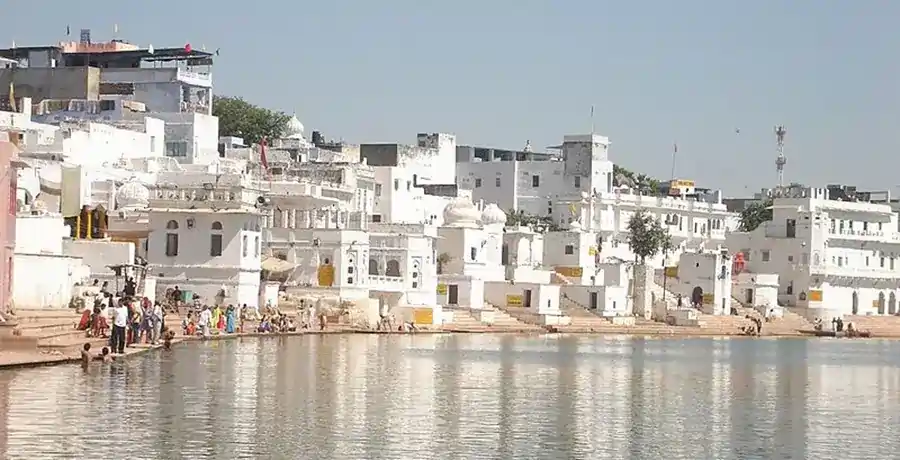
The Pushkar Lake, surrounded by the Aravalli Hills and dotted with numerous ghats (steps leading to the water), is a mesmerizing sight to behold. Visitors can take a leisurely stroll along the lakefront, offering prayers at the various temples, or simply sit and soak in the serene atmosphere. The Brahma Temple, dedicated to the creator god of Hinduism, is a must-visit attraction, with its intricate carvings and vibrant religious rituals.
Beyond the spiritual experiences, Pushkar also offers a vibrant cultural tapestry, with its bustling markets, colorful bazaars, and delectable local cuisine. The annual Pushkar Camel Fair, held in the month of Kartik (October-November), is a spectacular event that draws visitors from around the world to witness the unique spectacle of camel trading, cultural performances, and the celebration of Rajasthani heritage.
Exploring the royal city of Udaipur

While Jaipur may be the capital of Rajasthan, the city of Udaipur, located a few hours from Jaipur, is often considered the crown jewel of the state. This enchanting city, known as the “Venice of the East,” is a mesmerizing blend of history, architecture, and natural beauty that captivates the hearts of all who visit.
At the heart of Udaipur lies the majestic City Palace, a sprawling complex that serves as a testament to the grandeur of the Rajput dynasty. This iconic structure, built over several centuries, is a harmonious blend of Rajput, Mughal, and European architectural styles, creating a visually stunning and historically significant landmark.
As you wander through the City Palace, you’ll be awestruck by the intricate carvings, delicate mirror work, and opulent interiors that showcase the artistic talents of the Rajput craftsmen. The Manak Mahal, with its stunning mirrored walls, and the Mor-Chowk, with its exquisite peacock-themed frescoes, are just two of the many highlights that leave a lasting impression on visitors.
But the City Palace is not the only attraction that makes Udaipur a must-visit destination. The serene Lake Pichola, with its shimmering waters and the iconic Lake Palace floating upon it, is a sight to behold. Visitors can take a boat ride across the lake, enjoying the breathtaking views of the surrounding Aravalli hills and the historic Monsoon Palace, perched atop a nearby hill.
Beyond the iconic landmarks, Udaipur also offers a rich cultural experience, with its vibrant markets, delectable local cuisine, and traditional arts and crafts. The Jagdish Temple, a stunning 16th-century Hindu temple, is a hub of religious and cultural activity, where visitors can witness the rituals and ceremonies that have been practiced for centuries. The Saheliyon-ki-Bari, or the “Garden of the Maidens,” is a serene oasis of lush greenery and ornate fountains, offering a tranquil respite from the bustling city.
As the sun sets over Udaipur, the city takes on a magical quality, with the historic buildings and monuments illuminated against the backdrop of the Aravalli hills. It is in these moments that the true essence of Rajasthan’s royal heritage is revealed, inviting visitors to immerse themselves in the timeless beauty and grandeur of this enchanting destination.
Wildlife and nature experiences near Jaipur
While Jaipur and its surrounding historical landmarks are undoubtedly the main draw for many visitors to Rajasthan, the state also boasts a wealth of natural wonders that are equally captivating. Just a short distance from the Pink City lies the Ranthambore National Park, a renowned tiger reserve that offers a thrilling safari experience and the chance to witness the majestic Bengal tigers in their natural habitat.

The Ranthambore National Park is a vast expanse of lush forests, serene lakes, and rugged terrain that is home to a diverse array of flora and fauna. As you embark on a safari through the park, your senses will be heightened, as you keep a watchful eye for the elusive tigers that roam the landscape. The park’s experienced guides will lead you through the winding trails, sharing insights into the intricate ecosystem and the conservation efforts that have helped to protect these magnificent creatures.
Beyond the tigers, the Ranthambore National Park is a haven for a wide range of wildlife, including leopards, sloth bears, jackals, and a variety of bird species. The park’s diverse habitats, from the dense forests to the open grasslands, provide ample opportunities for visitors to witness the natural world in all its glory. The Ranthambore Fort, a historic landmark perched atop a hill within the park, adds to the enchantment, offering panoramic views of the surrounding landscape.
For those seeking a more serene and tranquil nature experience, the Sariska Tiger Reserve, located just a couple of hours from Jaipur, offers a captivating alternative. This protected area, nestled in the Aravalli Hills, is home to a variety of wildlife, including tigers, leopards, and a range of deer species. The park’s lush forests and picturesque landscapes provide a peaceful respite from the bustling city, allowing visitors to immerse themselves in the beauty of Rajasthan’s natural wonders.
Whether you’re an avid wildlife enthusiast or simply seeking a rejuvenating escape from the urban landscape, the nature reserves near Jaipur promise an unforgettable experience. From the thrill of spotting a majestic tiger to the serenity of exploring the Aravalli Hills, these destinations offer a unique glimpse into the rich biodiversity and stunning landscapes that make Rajasthan a true gem of India.
Conclusion: Plan your trip to Jaipur and nearby attractions
Jaipur, the captivating “Pink City” of Rajasthan, is undoubtedly a must-visit destination for any traveler exploring the wonders of India. However, the true essence of this enchanting region lies not only within the boundaries of Jaipur but also in the surrounding areas that offer a wealth of historical, cultural, and natural experiences.
From the majestic Amer Fort and the iconic Hawa Mahal to the serene Pushkar Lake and the thrilling safaris of Ranthambore, the places near Jaipur promise an unforgettable journey that will leave a lasting impression
